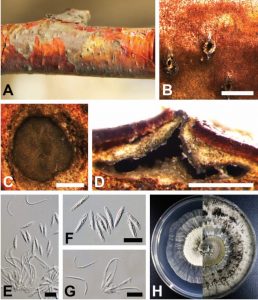Diaporthe betulicola C.M. Tian & Z. Du, sp. nov., Index Fungorum number: IF 570262
Holotype: BJFC-S1333
Etymology: betulicola, referring to Betula albosinensis, the known host for this species.
Host/Distribution: Pathogen on twigs and branches of Betula albosinensis in China
Sexual morph: Undetermined. Asexual morph: Conidiomatal pycnidial, conical, immersed, scattered, with a single locule. Ectostromatic disc brown to black, one ostiole per disc. Ostiole medium black, up to the level of disc, (110–)130–220(–240) µm (x̅ = 180 µm, n = 20) diam. Locule undivided, (680–)700–1300(–1350) µm (x̅ = 960 µm, n = 20) diam. Conidiophores reduced to conidiogenous cells. Conidiogenous cells hyaline, cylindrical, filiform, straight to curved. Alpha conidia hyaline, oblong, and acute at two sides, aseptate, smooth, not biguttulate, 10–14.5(–15) × 1.5–2.5 µm (x̅ = 12 × 2 µm, n = 50). Beta conidia hyaline, filiform, straight or curved, eguttulate, aseptate, apex acutely rounded, tapering from lower fourth towards base, 17–24 × 0.5–1(–1.5) µm (x̅ = 20 × 1 µm, n = 50).
Cultures: Colony originally compact and flat with white felty aerial mycelium, then developing white to light brown aerial mycelium, zonate with 3–5 well defined zones 0.5–1 cm wide with a regular smooth edge; conidiomata distributed in circularity over agar surface.
Material examined: CHINA, Shaanxi Province: Ankang City, Ningshan County, huoditang, 33°26’24.15”N, 108°26’46.30”e, 1625 m asl, on twigs and branches of Betula albosinensis, coll. Qin Yang, 3 April 2015 (BJFC-S1333, holotype), ex-type culture, CFCC 51128. Shaanxi Province: Baoji City, Feng County, Tangzang Town, Tongtian River Forest Park, 34°16’26.21”N, 106°31’39.58”e, 2127 m asl, on twigs and branches of Betula albosinensis, coll. Qin Yang, 31 July 2015 (BJFC-S1334, paratype) living culture, CFCC 51129.
Notes: This new species is distinguished from other Diaporthe species by its distinctive hyaline, oblong alpha conidia which are acute at both ends and lack guttules. It also has larger (10–14.5 × 1.5–2.5 µm) conidia, as compared to many other Diaporthe species. The most closely related species in the phylogram are D. woolworthii (Peck) Sacc. from Ulmus americana and Diaporthe rostrata C.M. Tian, X.L. Fan & K.D. hyde from Juglans mandshurica. Diaporthe woolworthii was introduced from Quercus from America (Saccardo 1882), but there are no illustrations, detailed descriptions or loanable specimens, and thus the species needs to be epitypified or provided with a reference specimen from the same country and host (sensu Ariyawansa et al. 2014). gomes et al. (2013) provided DNA data for this species using a putatively named strain, CBS 148.27, from Ulmus (a different host) in America. Two strains of D. betulina clustered in distinct clade in combined sequence analysis with high support (MP/ML/BI = 100/100/1), and differs from the strain of D. woolworthii (gomes et al. 2013). The new taxon also can be distinguished from D. rostrata, which has central perithecial necks, with a black conceptacle and shorter ellipsoidal alpha conidia (8.5–11.5 × 4–5 µm) (Fan et al. 2015).
Fig. 3. Morphology of Diaporthe betulicola from Betula albosinensis (BJFC-S1333). A, B habit of conidiomata on twig. C Transverse sections through conidiomata. D Longitudinal sections through conidiomata. e Conidiophores and conidia. F Alpha conidia. G Beta conidia. H Colonies on PDA at 3 days (left) and 30 days (right). Scale bars: B–D = 500 μm; E–G = 10 μm.

